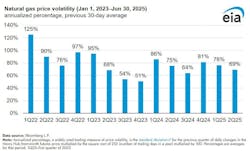First-half 2025 natural gas price volatility down in US
The average historical volatility of the daily Henry Hub front-month US natural gas futures price trended downward through first-half 2025, with quarterly volatility falling from a recent high of 81% in fourth-quarter 2024 to 69% by mid-2025, according to the US Energy Information Administration (EIA). This decline marks a return to more typical seasonal patterns and reflects greater market stability as storage inventories return to levels close to the 5-year average.
Since 2022, natural gas markets have experienced a series of extremes, including both unusually high and low inventory levels, which contributed to elevated price volatility. Recent quarters, by contrast, have seen more seasonally consistent price movements, suggesting that natural gas market dynamics have steadied amid record storage injections and more balanced inventories, EIA said.
At the end of first-quarter 2025, US Lower 48 natural gas storage volumes were 4% lower than the 5-year average. A polar vortex in January led to increased natural gas consumption, contributing to the fourth-largest weekly withdrawal from storage on record over the week ending Jan. 24, 2025. The large withdrawals contributed to 30-day historical volatility increasing to 102% on Feb. 3, 2025, the largest 30-day historical volatility since Mar. 8, 2023. Natural gas inventories continued to decline through the week ending Mar. 7, 2025, reaching a low of 1,698 bcf.
Volatility eased during second-quarter 2025 as weekly injections grew. From late April through June, net injections into storage were particularly robust, surpassing 100 bcf/week the week of April 25 for the first time in 2025, according to EIA’s Weekly Natural Gas Storage Report. Net injections totaled more than 100 bcf/week for seven consecutive weeks, the longest stretch since 2014.
Natural gas storage inventories began increasing the week of Mar. 14, and by the end of second-quarater 2025, inventories were 6% (173 bcf) above the 5-year (2020–24) average. Increased inventories and the pace of storage injections reduced concerns regarding supply availability, and price volatility declined.
